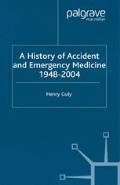Abstract
The most influential report into casualty or accident and emergency (A&E) services was the Standing Medical Advisory Committee Report on Accident and Emergency Services chaired by Sir Harry Platt and published in 1962.1,a This was a major milestone in the history of A&E and this chapter aims to describe medical staffing of casualty departments between the start of the NHS and that report.
Access this chapter
Tax calculation will be finalised at checkout
Purchases are for personal use only
Preview
Unable to display preview. Download preview PDF.
References
Standing Medical Advisory Committee. Accident and Emergency Services (1962) HMSO.
Brown L. (Ed). The New Shorter Oxford English Dictionary Vol 1 (A-M) (1993) Clarendon Press, Oxford.
Ell B. Reflexions of a lexicographer. Casuals and casualties. BMJ (1972) 1: 1113.
Abson EP. What is ‘emergency’? BMJ (1980) 280: 1536.
Moore N. The History of St Bartholomew’s Hospital Vol II (1918) C Arthur Pearson, London.
Abel-Smith B. The Hospitals 1800–1948 (1964) Heinemann, London.
Fissell ME. Patients, Power, and the Poor in Eighteenth-Century Bristol (1991) Cambridge University Press.
Clarkson P. Outpatient arrangements and accident services. Guy’s Hospital Gazette (1948) 31.7.48: 202–11.
Power D and Waring HJ. A Short History of St Bartholomew’s Hospital 1123–1923 (1923) St Bartholomew’s Hospital, London.
Louden ISL. Historical importance of outpatients. BMJ (1978) 2: 974–7.
Nuffield Provincial Hospitals Trust. Casualty Services and their Setting (1960) Oxford University Press.
Dale J. GPs in A&E departments in Salisbury C, Dale J and Hallam L (Eds) 24-hour Primary Care (1999) Radcliffe Medical Press, Abingdon.
Clarkson P. Timing in surgery and accident services. Guy’s Hospital Gazette (1949) 16.7.49: 219–23.
Patel AR. Modes of admission to hospital: a survey of emergency admissions to a general medical unit. BMJ (1971) 1: 281–30.
Catford EF. The Royal Infirmary of Edinburgh 1929–1979 (1984) Scottish Academic Press, Edinburgh.
Lowden TG. The casualty department: the work and the staff. Lancet (1956) 1: 955–6.
Lowden TG. The casualty department: shortcomings and difficulties. Lancet (1956) 1: 1006.
Lowden TG. The casualty department: a comprehensive accident service. Lancet (1956) 1: 1060–2.
Anonymous. Casualty department. Lancet (1960) 2: 689–90.
Lowden TG. The Casualty Department (1955) E&S Livingstone, Edinburgh.
Clarkson P. The role of casualty departments in the hospital service. Guy’s Hospital Gazette (1960) 74: 408–15.
Mestitz P. A series of 1817 patients seen in a casualty department. BMJ (1957) 2: 1108–9.
Caro DB. The Casualty Surgeons Association. Postgrad Med J (1972) 48: 260–1.
Parry CPB, Cooper BD, Shelswell ME, Dunkerley GE, Denham RA and Murray CMM. The Portsmouth Casualty Service. BMJ (1962) 2: 909–12.
Black WR. What is an accident? Lancet (1959) 2: 124–5.
Platt H. British Orthopaedic Association: first founders’ lecture. J Bone Joint Surg (Br) (1959) 41B: 231–6.
Osmond-Clarke H. Half a century of orthopaedic progress in Great Britain. J Bone Jt Surg (Br) (1950) 32B: 620–75.
Committee on Fractures. Report. BMJ (1935) 1(suppl): 53–62.
Quoted in BOA. Memorandum on Accident Services (1943) BOA.
Robb-Smith AHT. A Short History of the Radcliffe Infirmary (1970). Church Army Press Oxford for United Oxford Hospitals.
Joint Working Party (Chairman Sir Robert Platt). Medical Staffing Structure in the Hospital Service (1961) HMSO.
Shore E. Medical manpower planning. Health Trends (1974) 6: 2–5.
Royal Commission on Medical Education 1965–1968. Report (Todd Report) (1968) HMSO.
Hurst TW, Linfoot CB and Woodhouse TK. Junior medical staffing in hospital: five years of famine. Lancet (1953) 1: 1037–8.
Wynn WH. Shortage of junior hospital staff. Lancet (1952) 2: 125.
Anonymous. Shortage of house officers. Lancet (1954) 1: 181–2.
Anonymous. Medical Manpower (1966) Office of Health Economics, London.
Forrester RM and Walton JR. The senior registrar. Lancet (1953) 1: 793.
Shore E. Medical manpower planning. Health Trends (1974) 6: 32–5.
Clarkson P. Casualty departments in teaching hospitals. Lancet (1966) 2: 31–5.
Corbishley K. Shortage of casualty officers. Lancet (1953) 2: 454.
Gee A. Junior hospital staff. Lancet (1953) 1: 696–7.
Peyman MA. Casualty officer’s responsibility. Lancet (1953) 1: 545.
Smith KAH. Shortage of casualty officers. Lancet (1953) 2: 399.
CSA/BAEM Archive.
Memorandum submitted by SCO Subcommittee 30.10.63.
Minutes of SCO Subcommittee 30.10.63.
Abson EP and Caro DB. Senior Casualty Officers. BMJ (1965) 2: 941.
Fry L. Casualties and casuals. Lancet (1960) 1: 163–6.
Jones PF, Karmody AM and Galloway JMD. A children’s casualty department. BMJ (1966) 2: 819–21.
Tatham PH. Experience with an appointment system in a casualty department. Lancet (1966) 1: 1201–3.
Garden RS. The casualty department and the accident service. Lancet (1965) 1: 901–3.
Naylor A. The Bradford Accident Service 1960–1965. J Roy Coll Surg Edin (1967) 12: 264–74.
Wilson RI and Rutherford WH. The Belfast accident service. Injury (1972) 3: 169–75.
Hardy RH. Structure and function of a middle-sized accident department. BMJ (1974) 2: 596–600.
Wainwright D and Steel WM. Accident and emergency services in Stoke-on-Trent. Injury (1972) 3: 158–63.
Naylor A. The Bradford accident service. Injury (1972) 3: 148–57.
Denham RA. The accident and emergency service in Portsmouth — present and future. Postgrad Med J (1972) 48: 268–74.
Clarkson P. Some observations on the casualty department of New Guy’s House. Guy’s Hospital Gazette (1960) 74: 424–30.
Heaman EA. St Mary’s. The History of a Teaching Hospital (2003) McGill-Queens University Press, Montreal and Kingston, pp. 428–9.
Howard Baderman, personal communication.
Scott JC. Report on the Oxford Accident Service after 25 years. BMJ (1967) 2: 632–5.
Burrough EJR. Unity in Diversity: The Short Life of the United Oxford Hospitals (1978). Privately printed by author.
Plewes LW. Introduction in Accident Service. Plewes LW (Ed.) (1966) Pitman Medical Publishing Co, London.
Anonymous. ‘A pretty ghastly, awful picture’. BMJ (1961) 2: 1548–9.
Author information
Authors and Affiliations
Copyright information
© 2005 Henry Guly
About this chapter
Cite this chapter
Guly, H. (2005). Casualty Staffing before Platt. In: A History of Accident and Emergency Medicine, 1948–2004. Palgrave Macmillan, London. https://doi.org/10.1057/9780230000742_1
Download citation
DOI: https://doi.org/10.1057/9780230000742_1
Publisher Name: Palgrave Macmillan, London
Print ISBN: 978-1-349-52420-4
Online ISBN: 978-0-230-00074-2
eBook Packages: Palgrave History CollectionHistory (R0)

